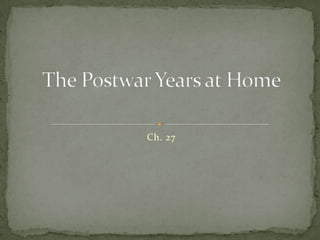The postwar years at home ch 27
•Als PPTX, PDF herunterladen•
1 gefällt mir•1,072 views
Melden
Teilen
Melden
Teilen

Empfohlen
Weitere ähnliche Inhalte
Was ist angesagt?
Was ist angesagt? (20)
Social impact of the great depression and new deal 

Social impact of the great depression and new deal
Chapter 17 Daily Life in the Gilded Age Powerpoint

Chapter 17 Daily Life in the Gilded Age Powerpoint
Ähnlich wie The postwar years at home ch 27
Ähnlich wie The postwar years at home ch 27 (20)
The 1950s (Post War Economy, Truman's Fair Deal, Technology, Suburbia)

The 1950s (Post War Economy, Truman's Fair Deal, Technology, Suburbia)
Chapter 19 section 1- underlined areas on Chapter 19 Test

Chapter 19 section 1- underlined areas on Chapter 19 Test
Mehr von phillipgrogers
Mehr von phillipgrogers (20)
Sections 4 and 5 - Greek Philosophers & Alexander the Great

Sections 4 and 5 - Greek Philosophers & Alexander the Great
Kürzlich hochgeladen
https://app.box.com/s/7hlvjxjalkrik7fb082xx3jk7xd7liz3TỔNG ÔN TẬP THI VÀO LỚP 10 MÔN TIẾNG ANH NĂM HỌC 2023 - 2024 CÓ ĐÁP ÁN (NGỮ Â...

TỔNG ÔN TẬP THI VÀO LỚP 10 MÔN TIẾNG ANH NĂM HỌC 2023 - 2024 CÓ ĐÁP ÁN (NGỮ Â...Nguyen Thanh Tu Collection
Kürzlich hochgeladen (20)
21st_Century_Skills_Framework_Final_Presentation_2.pptx

21st_Century_Skills_Framework_Final_Presentation_2.pptx
UGC NET Paper 1 Mathematical Reasoning & Aptitude.pdf

UGC NET Paper 1 Mathematical Reasoning & Aptitude.pdf
Sensory_Experience_and_Emotional_Resonance_in_Gabriel_Okaras_The_Piano_and_Th...

Sensory_Experience_and_Emotional_Resonance_in_Gabriel_Okaras_The_Piano_and_Th...
Beyond_Borders_Understanding_Anime_and_Manga_Fandom_A_Comprehensive_Audience_...

Beyond_Borders_Understanding_Anime_and_Manga_Fandom_A_Comprehensive_Audience_...
Exploring_the_Narrative_Style_of_Amitav_Ghoshs_Gun_Island.pptx

Exploring_the_Narrative_Style_of_Amitav_Ghoshs_Gun_Island.pptx
TỔNG ÔN TẬP THI VÀO LỚP 10 MÔN TIẾNG ANH NĂM HỌC 2023 - 2024 CÓ ĐÁP ÁN (NGỮ Â...

TỔNG ÔN TẬP THI VÀO LỚP 10 MÔN TIẾNG ANH NĂM HỌC 2023 - 2024 CÓ ĐÁP ÁN (NGỮ Â...
Fostering Friendships - Enhancing Social Bonds in the Classroom

Fostering Friendships - Enhancing Social Bonds in the Classroom
Python Notes for mca i year students osmania university.docx

Python Notes for mca i year students osmania university.docx
Food safety_Challenges food safety laboratories_.pdf

Food safety_Challenges food safety laboratories_.pdf
ICT Role in 21st Century Education & its Challenges.pptx

ICT Role in 21st Century Education & its Challenges.pptx
Basic Civil Engineering first year Notes- Chapter 4 Building.pptx

Basic Civil Engineering first year Notes- Chapter 4 Building.pptx
The postwar years at home ch 27
- 1. Ch. 27
- 3. The postwar years were a time of great economic growth in America. Between 1945 and 1960, the per capita income, or average annual income per person, rose considerably. American businesses switched from providing war needs to meeting increasing demand for consumer products. In order to protect against economic downturns, many formed conglomerates, corporations made up of three or more unrelated businesses.
- 4. Television — Television becomes a popular and powerful medium. Like the radio, TV gave people the same news, entertainment, and programming. Computers and Electronics — The invention of the transistor, a tiny circuit device that amplifies, controls, and generates electrical signals, revolutionizes computers and radios. Nuclear Power — Wartime nuclear research is put to peacetime use in nuclear power plants and nuclear- powered submarines. Advances in Medicine — Dr. Jonas Salk develops a vaccine against polio; advances in antibiotics and surgical techniques save countless lives.
- 5. The baby boom, or rise in birth rates, that had begun in the 1940s continued into the 1950s.
- 7. The GI Bill of Rights gave returning soldiers low- income mortgages, enabling many to buy homes in newly built suburbs The growth of suburbs led more Americans to rely on cars for everyday transportation. More and better roads were needed to support the increase in cars. The 1956 Federal-Aid Highway Act provided billions of dollars to build an interstate highway system. Cars became part of American culture as new businesses such as drive-in movies emerged.
- 8. The stimulus of money into housing caused a housing boom characterized by the development of the first suburban housing developments, such as Levittown, New York. The Levittown housing development became the proto-type for future developments. Floor plans were standardized and houses were designed to be mass produced in a 27 step process (much like an automobile).
- 9. The Peacetime Economy — Reconversion, the social and economic transition from wartime to peacetime, resulted in discrepancies between wages and prices. The Taft- Hartley Act of 1947 required a cooling-off period during which workers on strike from industries affecting the national interest had to return to work. The Fair Deal — Modeled on Roosevelt’s New Deal, Truman’s Fair Deal was a set of proposals for postwar economic improvement. Although some measures passed, many were rejected by Congress. Truman on Civil Rights — Truman formed the biracial Committee on Civil Rights in 1946 to address concerns of African Americans; opposition in Congress meant that change came slowly.
- 10. Although Truman’s Democratic Party was splitting and support for him was disintegrating, Truman chose to seek another term as President in 1948. With a blunt but effective campaign style, Truman won the election despite polls’ predictions against him. In response to Roosevelt’s unprecedented four terms as President, the Twenty-second Amendment was passed in 1951. This amendment specified that no President could serve more than two elected terms.
- 11. Although the language of the Twenty-second Amendment allowed Truman to run for President again in 1952, he chose not to do so. Republican Dwight Eisenhower and his running mate, Richard Nixon, were able to turn accusations about illegal campaign funding into support for their campaign. As President, Eisenhower advocated Modern Republicanism, an approach to government involving conservative economic policies but liberal social policies. Eisenhower’s administration favored big business and ending government competition for offshore oil lands. However, his presidency was marked by several economic recessions.